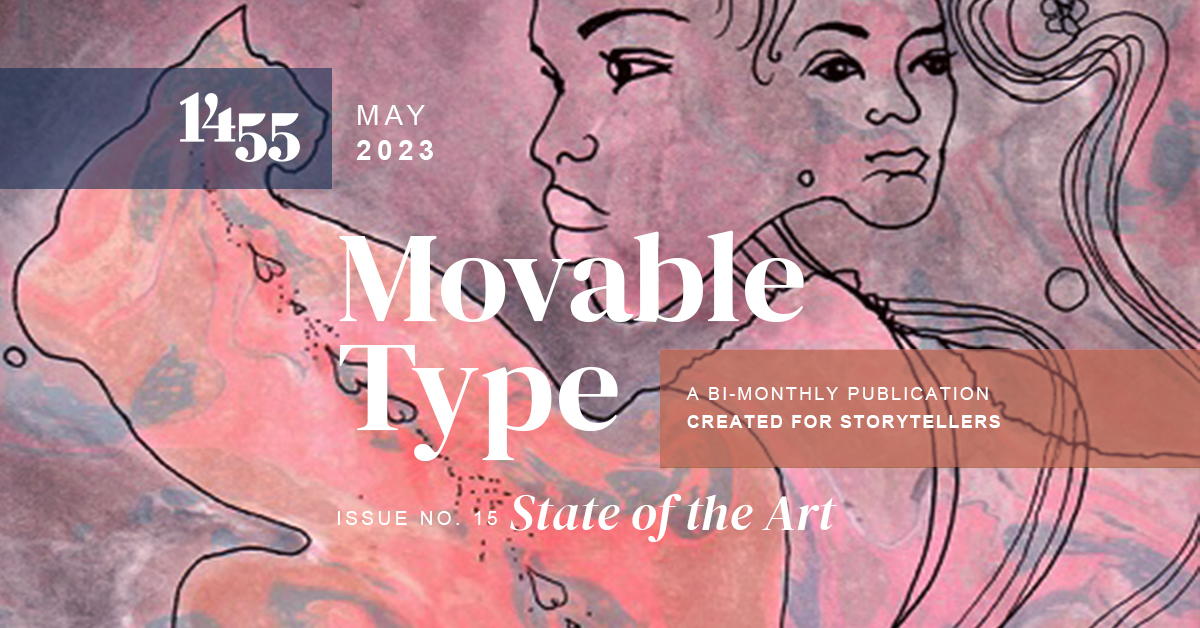Dr. Shawn Dubravac
Technological Waves and the
Changing Tides of Writing
Those whose feet were already on the first rung of the ladder of fame when the machine first became an accepted factor in the writing world shook their heads in dismay. Shivers ran down literary backbones. The mere thought of so much clatter in pouring out the fine distillation of delicately attuned mental processes brought down condemnation on the contraption. The art of letters, claimed these advocates of pen and pencil, would no longer be an art but a trade. Nimble fingers would mean nimble thoughts. Nimble thoughts would mean the end of careful weighing, careful choosing, and the careful setting forth of the results of that weighing and choosing.
Diane Rice, in a piece for the New York Times from 1924, highlights the apprehensions permeating the writing community at the emergence of a still relatively new, novel technology: the typewriter.
Of course, this would not be the last time that a new technology attempted to infiltrate and dismantle the fragile literary field. British poet Hugo Williams referred to the early word processor as a “grisly gulag of beige plastic.” Williams noted he preferred his Adler typewriter to any word processor because it “took the art of mechanical writing just as far as it could go before process started to impose its own louche values on the user, often without his knowledge. One more step down that road and it would cross the line dividing usefulness from hollow-eyed dependency.”
Angst arose when the word processor, like the typewriter before it, was on the precipice of forever disrupting the delicate balance between craftsmanship and convenience. Even the value of perhaps the earliest writing technology, that is writing itself, was questioned by Plato when he noted that writing will cause people to “cease to exercise memory because they rely on that which is written, calling things to remembrance no longer from within themselves, but by means of external marks… and as men filled, not with wisdom but with the conceit of wisdom, they will be a burden to their fellows.” Imagine being a burden to your peers because you read or wrote something instead of memorizing it.
The typewriter, or the word processor, or any number of other technologies, did indeed bring about significant changes in writing practices, but these did not diminish the artistry of writing as feared by some. Despite initial resistance, these technologies paved the way for increased efficiency and accessibility in writing, allowing for a broader participation in the world of letters. At their root, these tools created new workflows.
As time went on, writers began to embrace the benefits of these tools, recognizing that the true essence of their craft lay in the ideas and expressions they conveyed rather than the medium through which they were produced. It seems that even with new technologies, the careful weighing and the careful choosing still matter.
We now find ourselves at a new crossroads. But rather than running a slow pace parallel to the literary world, this next technological wave seems to be traveling at supersonic speed right across the heart of writing itself. Generative AI tools, through brute computing power, are seemingly generating language, letter by letter, word by word, stacking sentences upon sentences to form paragraphs and prose.
ChatGPT reached 100 million users in just its first two months, becoming the fastest growing consumer application in history. The impact on the writing world has been immediate. Today thousands of books have already been penned, (or “generated”) with the help of tools like ChatGPT. This is just the beginning, and Rice’s words are worth repeating: Those whose feet were already on the first rung of the ladder of fame when the machine first became an accepted factor in the writing world shook their heads in dismay.
To truly grasp how generative AI tools like ChatGPT will shape the literary world, we need to understand how technology exerts influence. Technological change never happens in a vacuum; rather, new technologies interact with forces already in play. Cultural movements. Geopolitical dynamics. Demographic shifts. In this way, it is often the second-order effects of technological change that are much larger and more impactful. If we want to see how generative AI changes writing we have to find the second-order effects. None of those have yet emerged.
Should the industry do more right now? Perhaps. The distinction between original and AI-assisted writing is blurry, and might require new frameworks and guidelines to navigate intellectual property rights. AI-generated content raises questions about authenticity and emotional depth. German artist Boris Eldagse recently declined a prestigious photography award as part of the annual Sony World Photography Awards program. His submission had been created with the use of AI and not a traditional camera, using prompts instead of light as he put it. The submission was within the guidelines but Eldagse hoped his entry would spark a dialogue about the intersection of photography and AI, ultimately leading to separate contests. It certainly succeeded in the former, but not the latter—at least not yet.
Regardless, it will be increasingly difficult to draw an arbitrary line between the end of human art and the start of AI magic. I’m sure all of the other recognized photos were touched up with the aid of powerful software. Could we ever clearly delineate a line? Can you imagine separate writing contests for those written with a typewriter and those without? Those might have made sense in 1924, but probably not today. Or perhaps separate writing contests for those who use a thesaurus and those who don’t. What technology tools are acceptable? If the answer is definitive in your mind, then the future will undoubtedly surprise you. In the end, any prize at any time reflects the current taste and preferences of judges and juries more than any innate skill held by the writer.
Let me leave you with five things to consider.
First, AI tools introduce a new dimension of collaboration between human writers and machine intelligence. These tools will serve as co-creators, offering inspiration, generating ideas, and even assisting in the actual writing process. This collaboration can expand the creative possibilities for authors. But like any other new-fangled writing tools, it is not required for creative writing: one needs to figure out how and where to integrate it. Some will use it early in the process, others later. And still others will follow Hugo Williams and avoid the “grisly gulag” altogether. Ultimately, it will change your workflow just like other technologies have, and finding the whatever solution(s) works best for you is what will make you most successful.
Secondly, you are the gardener tending the garden of your words. Technology has never excelled at expressing uncertainty. GPS systems for example are often overly definitive in what is ultimately a recommendation. Human conversation on the other hand is filled with filler words, pauses, and subtle body language to express nuance. We need to recognize that AI systems are far more insecure than we tend to assume.
Third, AI tools, like any other technology, can also be a distraction. Only we can ascertain how to use them to help and not hurt us.
Fourth, generative AI creates text inexpensively and whenever technology turns something from an expensive scarcity to an inexpensive abundance, we see the emergence of new use case scenarios. When image sensors went from a rare, expensive resource to an inexpensive, abundant resource, we went from only including an image sensor on the back of mobiles to also including one on the front of mobile phones. This small change revolutionized how we used the device with an explosion of selfies; indeed, selfie was the word of the year in 2013. Of course, we can also debate whether this was a bad thing, as more people die each year trying to take selfies than are killed in shark attacks. And of course, that front-facing camera really gave birth to the influencer economy.
Generative AI will produce an explosion of text—the shifting economics demand it. And like selfies, it won’t all be good. Matthew Kirschenbaum calls this coming tsunami textpocalypse. But I am not convinced that by cheaply making words, it makes words cheap. A similar fear percolated around self-publishing, and the pros and cons are still far from firmly established. And if we look back to the early 1900s, it seems that same fear swirled around the typewriter.
We will have to find ways to solve this problem and perhaps AI will help solve the concerns it creates. In the early days of email, spam was a vicious problem, one that was the result of the ease and inexpensive nature of the technology. In those early days, spam filters were horrible and most of us checked our spam folders as often as we checked our inbox. But gradually, technology learned how to overcome the negative externalities of email. Technological innovation is iterative.
Finally, humans have always found ways to add value when new technology emerges. The same will be true here, though it’s important to recognize the way humans add value often changes as technology exerts its force. The way we add value in the future will likely be different than it was in the past.
While concerns may arise with each new technological advancement, the resilience and adaptability of the writing community have consistently proven that the art of storytelling endures, regardless of the tools at hand.

Dr. Shawn Dubravac
Dr. Shawn DuBravac is an internationally-recognized thought leader and top-rated keynote speaker, delivering pragmatic and provocative insights on the trends, technologies and paradigms transforming the globe. His research focuses on the forces shaping tomorrow that are percolating on the peripheral of society and business today. By providing an elevated view of developing trends, DuBravac empowers leaders and their organizations to improve strategic decision-making capabilities by identifying and understanding the changing landscape and opportunities that lie ahead.
Today DuBravac is president of Avrio Institute. The Institute, which takes from the Greek Αύριο meaning tomorrow, helps leaders prepare for uncertain, divergent futures. It’s clients include Fortune 100 and Global 1000 companies, scrappy start-ups, government agencies and non-profit organizations. Grounded in economics, DuBravac served for over a dozen years as chief economist for the Consumer Technology Association (CTA), the U.S. trade association representing more than 2,000 consumer tech companies and owner and producer of CES.
Website: shawndubravac.com
Twitter: @shawndubravac
Facebook: facebook.com/sdubravac


